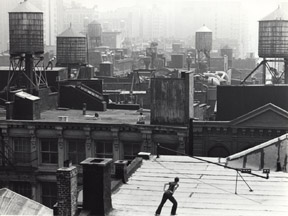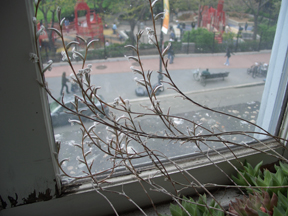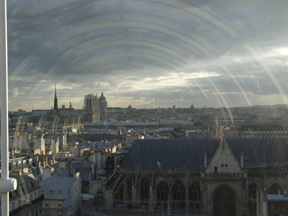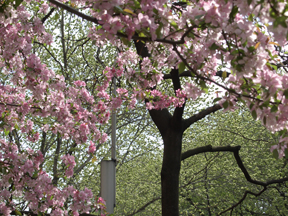| About Roof Piece | |||||||||||||||||||||||||
| How I Made Some of My Films | |||||||||||||||||||||||||
| The Making of Water Motor | |||||||||||||||||||||||||
| Living Somewhere | |||||||||||||||||||||||||
| Collecting as a Creative Process (coming soon...) | |||||||||||||||||||||||||
|
How I Made Some of My Films What Maisie Knew I started my first film in 1973 because my friend Chantal Akerman
who was going back to Europe gave me a box of outdated film stock
that she had and couldn’t take with her. Without any clear
idea other than exploring a young girl subjectivity and how she
sees grown-ups around her, I shot with some of my friends the scene
in the “loft with the fog” and some of the ‘solo”
for each of the five women. The reference to the Henry James’s
novel that I had read many years before when I was a teenager came
back to my consciousness in the fever of the feminist movement of
the early 1970s. Looking at the “fog” footage I elaborated
other scenes in the countryside and introduced male figures as “interlopers”.
I tied all the narrative strings together by shooting a series of
scripted scenes in what I called “the apartment with doors”
in fall 1974. WHAT MAISIE KNEW, 1975, 60 minutes, 16mm B&W. With Epp Kotkas, Kate Mannheim, Saskia Noordhoek Hegt, Linda Patton, Yvonne Rainer, Jerry Bamman, James Barth, John Erdmann, Gary Stephan & Philip Glass. (NOW) or Maintenant entre parenthèses (1976) I shot (NOW) in two hours more or less keeping everything
that was shot in continuity. I had a studio thanks to a friend that
was letting me her loft when she was away in France. So both Linda
Patton and James Barth came to the studio because I had asked them
to help me tryout things for what I then called “Film Portrait”
later titled “The Camera: Je”. At the time I was shooting
the same images both in B&W and Color and I did that on that
afternoon. The film shows a manipulation of objects and a kind of
literalness in the use of the word NOW that I liked. (NOW) or MAINTENANT ENTRE PARENTHESES,
1976, 16mm Color 10 minutes, The Camera : Je, La Camera : I (1977) The Camera : Je, La Camera : I is an exploration by the
photographer-filmmaker of the act of shooting photographs. The film
wants to make the spectator identifies with the eye of the photographer
on her subjects and the city she lives in, New York. The film uses
a technique of “subjective camera”, to give the spectator
an active sense of the dual problematic in the relation “cameraperson
to subject”, “photographing to photographed”.
This technique of “subjective camera” places the person
who looks at the film in the same relation with the screen as the
one of the photographer with her subjects. This strategy, therefore,
gives to the spectator a direct experience of the tension as well
as the wanderings and timing of a photographic session. The filmic
strategy makes the spectator understand and perceive the relation
between photographer and subject, a relation which is not about
dialogue but about power, power of saying yes or no to the taking
of the photograph, power however undermined by elements of anxiety,
coming from both sides, the photo subject and the photographer.
The situation is turned around at the end of the film when the power
is shown to belong to the performer on the screen, a spectator of
the photographs acting as a critic, looking at the photographs displayed
in front of him, and questioning by his look the work of the photographer.
THE CAMERA : JE, LA CAMERA : I, 1977,
16mm, B&W and Color, 88 minutes THE COLD EYE (MY DARLING BE CAREFUL) 1980 A “narrative” film centered on young artists living
in New York City around 1979. The Cold Eye (My darling Be Careful) is my third and last film of my “subjective camera cycle” that is exploring the spectator’s position when he or she is confronted with a direct gaze from the screen coming straight from the movie camera lens while being induced to an impossible identification with the character behind the camera who is implied in the film narration. In the case of the film The Cold Eye (My darling Be Careful)
all the protagonists look at you spectator while a voice that isn’t
your own but is the one of the film main character, Cathy (played
by Kim Ginsberg), who in the film narrative is occupying the camera’s
position. Cathy is answering questions or comments addressed at
you the spectator. The spectator is placed in a position where desynchronization
between eye and intellect is needed to cope. It is like an induced
schizophrenic split. The script, written by James Barth and based on a detailed outline by me, was completed for every scene before the rehearsal phase with the performers. I did several practice runs with each performer, using a still camera as a stand-in for the movie camera that I rented only for the shooting day. The only improvisation was in the camera work in the various locations, all in New York City. It is particularly the case in the art opening scene or in Alan’s apartment as well as in the café Borgia location. I wanted to show that Cathy is preoccupied by shapes and volumes rather than function and I could do it by exploring what and how she sees in her point of view shots. By showing how she sees, I imply how an artist in this case, a young woman painter, worked all the time at finding ideas about what is her main preoccupations while being also engaged in mundane conversation. Babette Mangolte September 2004 THE COLD EYE (MY DARLING BE CAREFUL),
1980, 16mm, B&W, 90 minutes There ? Where ? 1979 THERE? WHERE? 1979, 8 minutes, 16mm Color. With Cameron Bishop, Judith Spiegel, Babette Mangolte & Louis Hock Visible Cities 1991 VISIBLE CITIES, 1991, 31 minutes, 16mm Color. With Archer Martin and Christine Berry Music by Michael Pelz-Sherman What Maisie Knew (1975), There ? Where ?(1979) & Visible Cities (1991) The three films were made in different settings, at different times
and originated with different conceptual preoccupations but they
share one important premise about space, in particular domestic
space. Space defines us and defines the way we think, rather than
the other way around. THE SKY ON LOCATION 1982 The landscape is not seen in its postcardish grandeur as captured
in the photographs of Ansel Adams, nor through its shapes as in
a Cezanne or Constable paintings, but rather the film captures the
mood of the landscape as in a Turner painting. The film attempts
to construct geography of the land from North to South, East to
West and season-to-season trough colors instead of maps. The Sky on Location explores the concept of wilderness
that was unknown to me when I was raised in France. During the romantic
period at the junction between the eighteen and nineteen centuries,
the Europeans saw landscape in its majestic quality; they spoke
of its “grandeur” and dreamt of climbing the Alps. But
although the pikes could be inaccessible they were known and to
think a landscape essentially as untamed and wild is a concept of
the new continent with an unknown territory that had to be discovered.
I traced the history of this discovery and domestication of the
land in the painting of the Hudson River School where you see how
the unknown was slowly colonized and tamed. I also studied the photographic
surveys of the 1850s and 1860s to prepare the filming. THE SKY ON LOCATION, 1982, 16mm, Color,
78 minutes The film is a reconstitution of the seminal performance work done in the early Sixties by the sculptor Robert Morris. The filmmaker’s problematic was to create a film which, in the Nineties, can give a sense of the aesthetics of another generation without debasing it by transforming it. In particular the modernism concerns of the Sixties performance artists and dancers were centered on casual gestures and duration. Several of those preoccupation’s have been integrated in today’s dance vocabulary (like casual movement and untrained bodies), but some remain elusive, like the concept of theatrical time, which at the time was totally renewed in the performance work of the period due to John Cage’s enormous influence. Film is the medium of duration, but what we call duration is historically determined. Film spectatorship expectations greatly change in different generations. My biggest question was how to represent the sense of time of another generation. I gambled that if I could create a sense of heightened presence of the performer on screen by restructuring the sound space of the image, I could use the distended time-duration of the Sixties to my advantage and emphasize the importance of the performer’s body. The film’s premises rest on maintaining the concept of art
as displacement / art as a frame which I thought was at the center
of the impact of the performances at the time when their making
revolutionizes the new dance in the New York art scene of the early
Sixties. The making of the film was extremely pleasurable because the daily
contact with Robert Morris was intellectually stimulating and fun.
I also had all freedom to devise the complex tracking shots and
gliding camera work, which are meant to be seamless and invisible.
I trained myself to know the movement so well that I could guide
the tempo of the tracking shot by pure instinct. The task was particularly
challenging in Site and Waterman Switch. I also
felt that showing two renditions of Waterman Switch was
interesting, the first one emphasizing the proscenium effect of
the choreography, the other one using point of view shots and inducing
the spectator in the narrative. The sound track was the most interesting
element to invent for me. It is by sound that you create presence.
I feel very grateful that Robert Morris gave me total freedom in
the matter. FOUR PIECES BY MORRIS, 1993, 16mm, Color,
94 minutes Program Notes for Les Modèles de Pickpocket At a time when documentaries often means a hybrid between infocommercial and docudrama and when fake-documentary is lurking everywhere, my documentary Les Modèles de Pickpocket represents a return to a desire for authenticity that could seem out-dated and that I had never claimed in any of my previous films before. But authenticity is at the core of Robert Bresson’s filmmaking and is also a sign of a historical moment in the 1950s and 1960s where things, like objects were still scarce and when sounds and sensations in isolated forms mattered more than decorative kinetic displays and speed. I was also concerned with another kind of authenticity needed, forty years later, for historical validation. From the start, while working on the project, I felt strongly that whatever “facts” would be uncovered by my presence and interaction with the “models”, those facts themselves would not justify the enterprise. I needed to be able to establish a sense of presence that is at the center of the creation of authenticity in Bresson’s films and I also needed to evoke Bresson on his terms to give voice to his ideas so they could be bounced off the fragmented memories of the “models”. The strategy for my work as a filmmaker was simple: I had to be as unobtrusive as possible but as attentive as possible so the other, the “model” could feel that whatever was said was in confidence. I had to be a listener and de facto created a film that is about listening. Creating a sense of intimacy for the viewer was important and when I fail to raise the money to shoot on film, I felt that at least the tool of a small digital video camera could become an asset permitting me to work almost alone and with no heavy apparatus to move around. To capture Bresson’s voice, I worked in libraries and immerse myself in all the interviews that were published at the time preceding the making of Pickpocket and heard all the sound recordings and television documentaries done in the 1960s when Bresson’s fame peaked. This research about Bresson’s ideas in the late 1950s helped me when I had to convince the “models” to trust me and to give me access. In documentary, access as well as trust is everything. Babette Mangolte (September 2004) LES MODELES DE PICKPOCKET |



